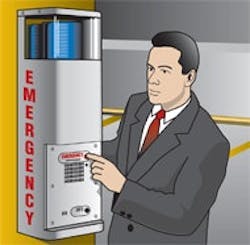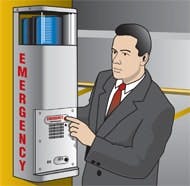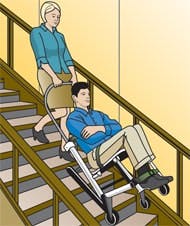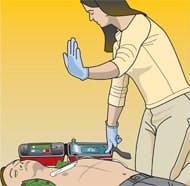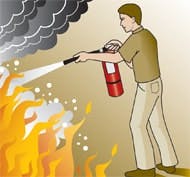George collapses from cardiac arrest while shopping with his wife. Carol senses she’s being followed on campus during her noon-hour run. A hospital nurse panics as Elliot, an emphysema patient, struggles to evacuate during a fire. Susan, a quadriplegic, prays for help as she waits in the stairwell while others evacuate from the burning office building. Every day, emergency situations like these arise.
The true test of how thorough your life safety plan is - and how well you’ve equipped your building and grounds - is proven by how these individuals respond. Will lives be saved and danger be averted? The answer is yes - if the property has been equipped with the right life-saving solutions.
Respiratory Protective Smoke Escape Devices (RPEDs)
If you’ve been proactive and conducted numerous evacuation drills, you’re probably sleeping easy at night, believing occupants can safely exit your building during a fire. However, you may want to extend your plans further to include respiratory protective smoke escape devices (RPEDs), commonly referred to as “smoke hoods.”
These handy devices provide protection to the head and eyes, and filter out carbon monoxide and many other toxic gases present in a building fire, giving the user greater time to evacuate before the damaging effects of smoke inhalation become life-threatening. “About three-quarters of all the fatalities in fires are a result not of the flames of the fire itself, but as a result of smoke and toxic gases in the smoke,” explains Derrick Russell, president and COO, Brookdale (a DuPont Canada company), Vancouver, BC.
In October 2003, the first American National Standard for RPEDs was published. Daniel K. Shipp, president of the Arlington, VA-based Intl. Safety Equipment Association (ISEA), had this to say in response to the ANSI/ISEA 110-2003 standard and the rising interest in smoke hoods: “Many consumers concerned about having time to escape during building fires have bought RPEDs in the last several years. They have also been popular with operators of hotels, apartments, office buildings, hospitals, and other large structures that house many people but have limited escape routes in the event of a fire.”
As Shipp points out, the use of smoke hoods is not limited to multi-story buildings, but can be used effectively in any space where the ability of individuals to evacuate quickly may be hampered (perhaps due to the medical conditions of employees or hospital patients, or proximity to an exit). “It can be a long way to fresh air from the middle of a warehouse to the end of a large warehouse - even though it’s only a 1-story building,” notes George Blank, marketing manager, Respiratory Protection Products, NAFTA Region, Drager Safety Inc., Pittsburgh.
When investigating smoke hoods, it’s necessary to consider the following prior to purchase:
- Service and shelf life. If the claim sounds too good to be true, it probably is. The ANSI/ISEA standard specifies an RPED with a 15-minute service life. Additionally, unused smoke hoods will eventually expire. Expect a shelf life of approximately 5 years.
- Ease of use. Look at the smoke hood and consider its use by a non-English-speaking person, or an individual with poor eyesight. “All the products that we [manufacture] have pictograms on the exterior of the packages so they can remind themselves how to put the unit on. And also, since the pictograms are there, it removes any language barriers,” says Blank.
- Training. Consider how much assistance the manufacturer can lend with training. While the product should be easy to use for anyone (even individuals who have not been trained), it’s recommended that instruction be provided as part of routine emergency evacuation procedures. “Each unit comes with an instruction manual with detailed instructions for use. Many manufacturers also have videos on their websites that users are encouraged to watch,” says Russell.
Smoke hoods can be purchased for placement in office workstations, or multi-unit dispensers can be strategically located outside stairwell doors or in common areas like cafeterias and boardrooms. “[Most importantly], make sure employees know where they are and know how to use them,” says Russell.
Emergency Communication Systems
One of the most proactive approaches to security and life safety is the installation of emergency communication devices. It’s likely that they are already installed in your facility’s elevators; however, are they are ADA compliant? Check to see if your system meets the ADA Accessibility Guideline 4.10.14 and ASME A17.1-1990 requirements.
Another place emergency phones have been mandated is in areas of rescue assistance (places of refuge where handicapped individuals unable to evacuate during emergencies wait for help). While these two applications are the most typical locations of emergency communication, they are not the only places where the systems can be installed to improve life safety and security response. “There [are] a lot of what we would call ‘passive’ security devices out there. The telephone is a proactive device. If somebody feels threatened or just needs some help, they can actually - [with the] push of a button - make a phone call to get some help,” explains Carl Gandolfo, national sales manager, Code Blue Corp., Chicago.
More and more, facilities professionals and operators of parking structures are recognizing the value of installing emergency phones. “Parking lots have special problems or risks that can be associated with them - they’re used 24 hours a day, they’re not open to visibility - so the need for emergency communications can be easily seen,” say Samuel Shanes, chairman of the board, Talk-A-Phone, Chicago. Placing emergency phones in parking lots and garages enables individuals to approach a two-button phone system and either trigger emergency response (if a person is being attacked or threatened) or call for assistance (if individuals are unable to locate their vehicle, have locked their keys in the car, or need a jump-start due to a dead battery).
College and business campuses have found pole-mounted emergency phones beneficial not only for their ability to lend assistance to individuals in emergency situations, but also by providing a heightened sense of security and safety.
If you’re considering enhancing your property’s life safety by investing in emergency communication systems, ask the following questions:
- Are the products ADA compliant?
- Does the line of emergency communication systems offer a range of products to meet the individual needs of each application?
- Is the enclosure vandal and graffiti resistant, and is the paint UV resistant?
- Can security cameras and access card readers be integrated into the phone system?
- Does the product’s software offer remote programming diagnostics? Or will security guards and facilities personnel be required to manually check these phones to ensure they are operating properly?
- Will the product identify the location of the caller, or does this individual need to provide that information to the responder?
- Does the emergency phone include a strobe light?
- Can the manufacturer/dealer/distributor demonstrate the product in the location where it will be used? “If you want to put a phone next to a loading dock, and you know that you’re going to have trucks coming in and out of there, that’s where we’ll set up the phone for you so that you can hear what that phone sounds like,” says Gandolfo.
- Are solar-powered units available?
- Can the product be connected to a WiFi network, if desired?
By ensuring compliance with building codes and placing additional emergency communication systems in areas where incidents are likely, building owners are conveying a commitment to the life safety of individuals while reducing the chances of litigation.
Evacuation Chairs
While areas of rescue assistance have been the recommended approach to addressing disabled persons during an evacuation situation, options are available so that individuals do not have to be left in an emergency. Despite what codes require, the industry is awakening to a more proactive approach. James M. Shannon, president and CEO of the Quincy, MA-based National Fire Protection Association, feels strongly that greater emergency planning for disabled persons is a must. On Feb. 8, 2005, Shannon made the following statement: “We simply cannot leave people who have disabilities in a building during any emergency - whether it is fire, power failure, or bomb threat - hoping that someone will go back to assist them.”
The purchase and use of evacuation chairs in commercial, institutional, and government buildings has enabled the safe evacuation of disabled individuals in numerous situations, the most haunting of which occurred on 9/11. Evacuation chairs differ from stair chairs - they glide down steps on belted rollers rather than incorporating handles to carry an individual.
When asked where these chairs are most appropriate, Robert McLean, sales manager, EVAC+Chair Corp., New York City, replied, “Wherever there are people and stairs - it’s that simple.” While a skeptic may think that these chairs are necessary only where occupants include handicapped persons, this thinking neglects to consider any number of individuals who may require assistance. “[Users] could be people who are obviously disabled in wheelchairs, women who are in their last term of pregnancy, people who have had a skiing accident and now have a broken leg - all of these individuals cannot walk down stairs,” McLean explains. Also consider individuals with “invisible” disabilities such as emphysema, or those who, due to an emergency situation, could become disabled.
When considering evacuation chairs for your facility, take the following points into consideration:
- The chair should be easy to operate, and the individual assisting the disabled person should be equal to or greater in weight.
- Evacuation chairs can be located in the area occupied by a known disabled individual, or mounted on the wall outside stairwell doors.
- Manufacturers often provide training materials such as videos and written instruction.
- It’s advisable that evacuation coordinators or floor wardens practice use of the chairs during regular drills to better familiarize themselves with both their location and operation.
- When considering purchasing an evacuation chair, give it a test drive and test ride.
Automated External Defibrillators (AEDs)
Cardiac arrest is the cause of death for between 300,000 and 400,000 Americans each year, according to the Arlington Heights, IL-based American College of Occupational and Environmental Medicine (ACOEM) October 2003 report titled, Utilization and Impact of AEDs in the Workplace: A Survey of Occupational Health Physicians. “The American Heart Association has estimated that if AEDs were widely deployed in America, they’d save about 50,000 lives a year,” adds Raymond W. Cohen, chairman and CEO, Cardiac Science Inc., Irvine, CA.
The availability of AEDs, or automated external defibrillators, can help people act fast, respond to an individual who suddenly suffers from cardiac arrest, and shock their heart back into its natural rhythm. These devices’ sensitive monitoring capabilities analyze the rhythm of a victim’s heart, only instructing or administering a shock if necessary.
Integration of AEDs in workplaces, public venues, and schools is becoming more common - and for good reason. The ACOEM study reports survival rates of between 50 and 90 percent when defibrillation is administered early enough. Without the use of an AED, an individual’s chance of survival is a mere 5 percent. “Time is incredibly important. For every minute that goes by without defibrillation, the chance of the [person] surviving decreases by 7 to 10 percent,” explains Julie S. Milner, director of field marketing, North America, Cardiac Resuscitation Solutions, Philips Medical Systems, Andover, MA.
Before you rush to buy AEDs for your facility, do some homework. This list of considerations should help with the purchase and implementation of AEDs:
- Wonder where to install AEDs? “The American Heart Association (AHA) has supplied guidelines for the distance in which one AED should be placed from another. What the [AHA] says is ... that they should be located no more than a 3-minute brisk walk from one to the next,” says Cohen.
- Training should accompany the purchase of AEDs. Many manufacturers offer courses. Alternatives include training from the American Heart Association or American Red Cross.
- When comparison-shopping, determine whether the following features are important: a visual display (in addition to voice prompts) so the AED can be operated in noisy environments, or by the hearing-impaired; a self-testing mechanism; and CPR coaching.
- Don’t forget to check the battery and shelf life, length of the warranty, and reputation of the manufacturer. The AED should be lightweight and easy to use. Request a demonstration.
To quell the fears of individuals, the government signed into effect the Cardiac Arrest Survival Act in 2000. “It’s a Good Samaritan Law that basically says any person who has undergone a 4-hour AED CPR training course ... can intervene and use these devices in an emergency situation and [be] free of any liability,” explains Cohen.
Fire Extinguishers
While NFPA 10, the standard for portable fire extinguishers, mandates the placement, type, and number of extinguishers required, the code cites the minimum actions necessary. Maybe it’s time to ask yourself whether your buildings are complying, and if occupants know how and when to use extinguishers. A resounding “no” is your first cue that the life and fire safety plan you once thought was thorough could be inadequate.
If the idea of calling together everyone in the building for small training sessions seems like too much of a headache, consider using the Internet. “Brooks Equipment Co. has developed a free website (www.fireextinguisher.com). Anybody who has access to the Internet can go to that site and receive training in the use of hand-[held] portable fire extinguishers,” says Craig Voelkert, vice president of sales, Special Hazards, Amerex Corp., Trussville, AL. “Now, building owners and facility managers have that tool available to them. It’s very user-friendly.” Don’t forget that an important aspect of training is making occupants aware of extinguisher locations.
Training and compliance, however, may not be the problem; maintenance could be. “They’re mechanical devices, and they’re also pieces of safety and emergency equipment. As a result, fire extinguishers do have to be maintained,” says Voelkert. “They need to be checked by a professional annually.” NFPA 10 provides guidelines for a regular maintenance routine, and an experienced fire equipment professional can provide maintenance and inspection services.
It’s important to recognize that, although building codes may not mandate all of the equipment and devices noted in this article, providing shoppers, guests, employees, and visitors with the equipment they need to help themselves and others in a life-threatening situation is worth exploring. In some cases, the cost is steep; in others, it’s minimal. Regardless, everyone agrees: You can’t put a price on human life. Consider making these investments today.
Jana J. Madsen ([email protected]) is managing editor at Buildings magazine.
